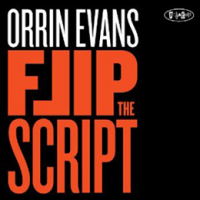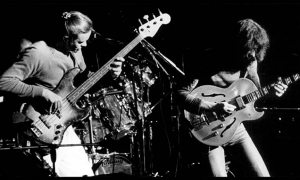Home » Jazz Articles » We Travel the Spaceways » The Rocket Ship Takes Off
The Rocket Ship Takes Off
But this is good news, why? Because pushing jazz and improvised music out of major labels has been a windfall for small labels, independent artists and jazz listeners.
Think about it, innovation in jazz has rarely come from the major labels anyway. Alfred Lion's Blue Note Records was once just a small start-up, as was Jost Geber's FMP (Free Music Production). Pioneering presenters, like today's Emanem label under the command of Martin Davidson, and Portugal's Clean Feed, push the boundaries of jazz and improvised music. Hell, even the neocons, the Marsalis family, started their own label. Artists today do not require the stamp of approval by a major label to present their music. Trumpeter Dave Douglas established Greenleaf Music, Jonas Kullhammar Moserobie, and Peter Gordon with Matthew Shipp Thirsty Ear, to name just a few. Music that once never made it past the old corporate boardroom and into the recording studio is being lovingly produced in studios, basements, garages and captured live. The boundaries of exactly what constitutes the kingdom of jazz and improvised musics are ever expanding.
This column will explore some of the latest efforts by small labels, innovative and entrepreneurial artists, and boundary skating musicians that push the definition of what it means to be a jazz and improvising artist. The question, "is it jazz?" will never be asked (or answered) here. What is vital to the advancement of this thing called jazz is that the answers found here will be to the questions, "What the hell was that?" "Is it interesting?" and "Why is this important?"
Let's begin our travels.
 Travis Laplante
Travis LaplanteHeart Protector
Skirl Records
2012
Nowhere is the exploration of the space ways more extreme than in solo performance. It is perhaps also the most consequential. Ever since Anthony Braxton's For Alto (Delmark, 1968) and Tenor And Fallen Angels (hatOLOGY, 1977) by Joe McPhee were released, connoisseurs of the solo improvisor have sought out musicians such as Travis Laplante. The saxophonist can be heard in the band Little Women, beside fellow saxophonist Darius Jones or in a new quartet with Ingrid Laubrock. His Heart Protector (Skirl, 2011) is a solo tenor outing that in five tracks travels the space between meditative multi-phonics to some circular-breathing overblown passages. Laplante has a sound, like say Evan Parker, that can easily hypnotize and mesmerize listeners. The highlight here might be the simple melody of "The Tear Dam," played as a repeating pattern that swells with emotion, leaving the listener wanting just a little bit more. His contribution to sound is the ongoing efforts to standardize extended saxophone techniques.
 Ches Smith's Congs for Brums
Ches Smith's Congs for BrumsPsycho Predictions
88 Records/Preposterous Bee
2012
Give drummer Ches Smith a studio, some recording time, and the side man to the likes of Tim Berne, Mary Halvorson, and Marc Ribot, and he will come up with some tantalizing solo sounds as on Psycho Predictions. This outing, recorded as one continuos piece with no overdubs, finds the multitasking Smith working both drums, vibraphone and some queued electronics to create a spacious and very gratifying suite of music. His playing overlaps the phases of electronics with a plethora of beats. Some electronica, some rock, there are no simple tag lines here. Smith serves his composition up at times repeating pattern ala Steve Reich, other times with echoey phases. The result is a dreamy and mesmerizing experience.
 Matthew Bourne
Matthew BourneMontauk Variations
The Leaf Label
2012
Supply a pianist some recording time, a fine instrument and a blank slate, and the results can be magnificent. Think of pianist Keith Jarrett's now infamous Koln Concert (ECM, 1975) and its influence today on electronic keyboard genius Bugge Wesseltoft and his contemporary, Matthew Bourne. The British pianist Bourne is comfortable in both electric and acoustic settings, playing thoroughly composed and the improvised music heard on Montauk Variations. This, his first solo studio release is a stripped down, almost minimalist affair. Bourne chose mostly soft tones, occasionally skipping across the insides of the piano. But even his dissonance is tempered. He does overdub some cello parts to create a complete scrapbook of his thoughts. The disc ends with Charlie Chaplin's "Smile." Stripped to its barest, the sense of melancholia conjured is discreetly ravaging.
 Lucio Capese
Lucio CapeseZero Plus Zero
Potlatch Records 2012
Argentinean born, European resident sound artist Lucio Capese pares sound all the way down to the harmonic beginnings of the universe. On Zero Plus Zero he uses various instruments; the struti box, soprano saxophone, bass clarinet, double plugged equalizer, ring modulator and sine waves to create primordial tones that resonate an innate impulse. This very minimalist recording relies on varying frequencies and electronic hum to set the stage. Capese prepares his saxophone and bass clarinet with applied objects and preparations that include cardboard tubes and metal. The mesmeric nature of these sounds is the gift here. Capese, like all great electroacoustic improvisors, lays out slow moving textures, emotions, and shapes, all for prayer, meditation, or rumination.
 David Buddin
David BuddinCanticles For Electronic Music
ugEXPLODE Records 2012
Classical music, or modern classical music, has played a role in shaping free improvisation and chamber jazz for quite some time now. I'm not talking saxophonist Charlie Parker with strings, but Karlheinz Stockhausen and Charles Ives. Dipping into that contemporary context is David Buddin. On Canticles For Electronic Music he explains that he took "a single six-note ordered set and its canonical transformations" and performed them electronically over varying intervals and durations. The result is a dazzling and brilliant document of a synthesizer music box machine performance. A sort of R2D2 chamber recital.
 Jonah Parzen-Johnson
Jonah Parzen-JohnsonMichiana
Primary Records 2012
Baritone saxophonist Jonah Parzen-Johnson presents a dusky set of illuminated solo pieces that resonate the simplicity and unpretentiousness of folk music as played by an improvising jazz artist. Michiana comprises 9 tracks, plus two remixes. Each piece a prayer or musing. Parzen-Johnson's approach restricts the sometimes overbearing vocalizations and extended techniques such as multi-phonics and circular-breathing in service to the music itself. Meaning, his technique does not get in the way of his message. The overblown-vocalization passage on "Never Meant To Keep In Touch" doesn't detract, and his insouciant approach suggests a solitary bluesman playing for no one in particular. The work is meditative, deliberate and considerate. The two remix pieces, both working with the composition "I Turn Left Over The Train Tracks," fraternize electronics with pieces of Parzen-Johnson's baritone. Both are a window (hopefully) to the artist's next project.
Tracks and Personnel
Heart Protector
Tracks: Heart Protector; Five Points; The Great Mother; She Heals As She Harms; The tear Dam.
Personnel: Travis Laplante: tenor saxophone.
Psycho Predictions
Tracks: Death Chart; Birth Chart; Conclusion: That's Life.
Personnel: Ches Smith: drums, percussion, vibraphone; electronics.
Montauk Variations
Tracks: Air; The Mystic; Phantasie; Infinitude; Etude Psychotique; Within; One For You, Keith; Juliet; Senectitude; The Greenkeeper; Abrsde; Here; Gone; Knell; Cuppa Tea; Unsung; Smile.
Personnel: Matthew Bourne: piano, cello.
Zero Plus Zero
Tracks: Some Move Upward Uncertainty (For Harley Gaber); Zero Plus Zero; Inside The Outside I; Inside The Outside II; Spectrum Of One (onr the 50th anniversary of the first photograph of Earth taken from space); Inside The Outside III.
Personnel: Lucio Capece: struti box, soprano saxophone double plugged equilizer, ring modulator; bass clarinet, cassette, minidisc walkmans; tunes backyard; sine waves;
Canticles For Electronic Music
Tracks: Canticle I; Canticle II; Canticle III; Canticle IV; Canticle V; Canticle VI.
Personnel: David Buddin: synthesizer.
Michiana
Tracks: I Turn Left Over The Tracks I; If He Was Just Scared, Then That's OK; Wet Rocks; You Probably Don't Remember; In Michigan City The Railroad Runs In The Road; Never Meant To Keep In Touch; Some Pictures Can't; I Turn Left Over The Tracks II; You Fell Asleep And I Didn't Mind, But Then I woke You Up; I Turn Left Over The Tracks III (The Building Remix); I Turn Left Over The Tracks IV (Lenny Pickett Remix).
Personnel: Johah Parzen-Johnson: baritone saxophone.
Tags
We Travel the Spaceways
Sun Ra
Mark Corroto
United States
wynton marsalis
Dave Douglas
anthony braxton
Joe McPhee
Darius Jones
Ingrid Laubrock
evan parker
Ches Smith
Tim Berne
Mary Halvorson
Marc Ribot
Keith Jarrett
Bugge Wesseltoft
PREVIOUS / NEXT
Support All About Jazz
 All About Jazz has been a pillar of jazz since 1995, championing it as an art form and, more importantly, supporting the musicians who make it. Our enduring commitment has made "AAJ" one of the most culturally important websites of its kind, read by hundreds of thousands of fans, musicians and industry figures every month.
All About Jazz has been a pillar of jazz since 1995, championing it as an art form and, more importantly, supporting the musicians who make it. Our enduring commitment has made "AAJ" one of the most culturally important websites of its kind, read by hundreds of thousands of fans, musicians and industry figures every month.


























